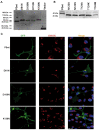A novel mouse model of CMT1B identifies hyperglycosylation as a new pathogenetic mechanism
- PMID: 35908287
- PMCID: PMC9759335
- DOI: 10.1093/hmg/ddac170
A novel mouse model of CMT1B identifies hyperglycosylation as a new pathogenetic mechanism
Abstract
Mutations in the Myelin Protein Zero gene (MPZ), encoding P0, the major structural glycoprotein of peripheral nerve myelin, are the cause of Charcot-Marie-Tooth (CMT) type 1B neuropathy, and most P0 mutations appear to act through gain-of-function mechanisms. Here, we investigated how misglycosylation, a pathomechanism encompassing several genetic disorders, may affect P0 function. Using in vitro assays, we showed that gain of glycosylation is more damaging for P0 trafficking and functionality as compared with a loss of glycosylation. Hence, we generated, via CRISPR/Cas9, a mouse model carrying the MPZD61N mutation, predicted to generate a new N-glycosylation site in P0. In humans, MPZD61N causes a severe early-onset form of CMT1B, suggesting that hyperglycosylation may interfere with myelin formation, leading to pathology. We show here that MPZD61N/+ mice develop a tremor as early as P15 which worsens with age and correlates with a significant motor impairment, reduced muscular strength and substantial alterations in neurophysiology. The pathological analysis confirmed a dysmyelinating phenotype characterized by diffuse hypomyelination and focal hypermyelination. We find that the mutant P0D61N does not cause significant endoplasmic reticulum stress, a common pathomechanism in CMT1B, but is properly trafficked to myelin where it causes myelin uncompaction. Finally, we show that myelinating dorsal root ganglia cultures from MPZD61N mice replicate some of the abnormalities seen in vivo, suggesting that they may represent a valuable tool to investigate therapeutic approaches. Collectively, our data indicate that the MPZD61N/+ mouse represents an authentic model of severe CMT1B affirming gain-of-glycosylation in P0 as a novel pathomechanism of disease.
© The Author(s) 2022. Published by Oxford University Press. All rights reserved. For Permissions, please email: journals.permissions@oup.com.
Figures









Similar articles
-
Activation of XBP1s attenuates disease severity in models of proteotoxic Charcot-Marie-Tooth type 1B.Brain. 2025 Jun 3;148(6):1978-1993. doi: 10.1093/brain/awae407. Brain. 2025. PMID: 39979221 Free PMC article.
-
Pathology of a mouse mutation in peripheral myelin protein P0 is characteristic of a severe and early onset form of human Charcot-Marie-Tooth type 1B disorder.J Cell Biol. 2004 May 24;165(4):565-73. doi: 10.1083/jcb.200402087. Epub 2004 May 17. J Cell Biol. 2004. PMID: 15148307 Free PMC article.
-
Major myelin protein gene (P0) mutation causes a novel form of axonal degeneration.J Comp Neurol. 2006 Sep 10;498(2):252-65. doi: 10.1002/cne.21051. J Comp Neurol. 2006. PMID: 16856127
-
De novo mutation (Arg98-->Cys) of the myelin P0 gene and uncompaction of the major dense line of the myelin sheath in a severe variant of Charcot-Marie-Tooth disease type 1B.J Neurol Sci. 1997 Jul;149(1):103-9. doi: 10.1016/s0022-510x(97)05400-2. J Neurol Sci. 1997. PMID: 9168174 Review.
-
Phenotypic clustering in MPZ mutations.Brain. 2004 Feb;127(Pt 2):371-84. doi: 10.1093/brain/awh048. Epub 2004 Jan 7. Brain. 2004. PMID: 14711881 Review.
Cited by
-
A new mouse model of Charcot-Marie-Tooth 2J neuropathy replicates human axonopathy and suggest alteration in axo-glia communication.PLoS Genet. 2022 Nov 9;18(11):e1010477. doi: 10.1371/journal.pgen.1010477. eCollection 2022 Nov. PLoS Genet. 2022. PMID: 36350884 Free PMC article.
-
Homomeric interactions of the MPZ Ig domain and their relation to Charcot-Marie-Tooth disease.Brain. 2023 Dec 1;146(12):5110-5123. doi: 10.1093/brain/awad258. Brain. 2023. PMID: 37542466 Free PMC article.
-
Navigating the Landscape of CMT1B: Understanding Genetic Pathways, Disease Models, and Potential Therapeutic Approaches.Int J Mol Sci. 2024 Aug 26;25(17):9227. doi: 10.3390/ijms25179227. Int J Mol Sci. 2024. PMID: 39273178 Free PMC article. Review.
-
Basic Pathological Mechanisms in Peripheral Nerve Diseases.Int J Mol Sci. 2025 Apr 4;26(7):3377. doi: 10.3390/ijms26073377. Int J Mol Sci. 2025. PMID: 40244242 Free PMC article. Review.
-
Mechanisms and treatment strategies of demyelinating and dysmyelinating Charcot-Marie-Tooth disease.Neural Regen Res. 2023 Sep;18(9):1931-1939. doi: 10.4103/1673-5374.367834. Neural Regen Res. 2023. PMID: 36926710 Free PMC article. Review.
References
-
- Sherman, D.L. and Brophy, P.J. (2005) Mechanisms of axon ensheathment and myelin growth. Nat. Rev. Neurosci., 6, 683–690. - PubMed
-
- Jessen, K.R. and Mirsky, R. (2005) The origin and development of glial cells in peripheral nerves. Nat. Rev. Neurosci., 6, 671–682. - PubMed
-
- Patzig, J., Jahn, O., Tenzer, S., Wichert, S.P., de Monasterio-Schrader, P., Rosfa, S., Kuharev, J., Yan, K., Bormuth, I., Bremer, J. et al. (2011) Quantitative and integrative proteome analysis of peripheral nerve myelin identifies novel myelin proteins and candidate neuropathy loci. J. Neurosci., 31, 16369–16386. - PMC - PubMed
-
- Filbin, M.T., Walsh, F.S., Trapp, B.D., Pizzey, J.A. and Tennekoon, G.I. (1990) Role of myelin P0 protein as a homophilic adhesion molecule. Nature, 344, 871–872. - PubMed
-
- Shapiro, L., Doyle, J.P., Hensley, P., Colman, D.R. and Hendrickson, W.A. (1996) Crystal structure of the extracellular domain from P0, the major structural protein of peripheral nerve myelin. Neuron, 17, 435–449. - PubMed
Publication types
MeSH terms
Substances
Grants and funding
LinkOut - more resources
Full Text Sources
Medical
Molecular Biology Databases

